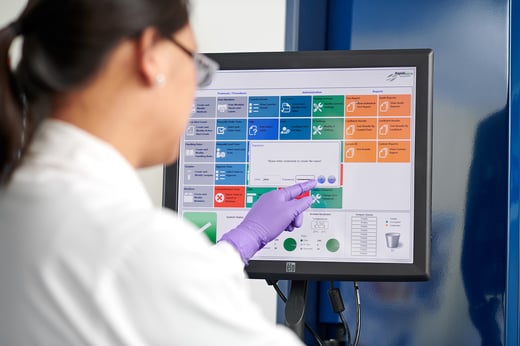blog
April 3, 2023 | Source: Rapid Micro Biosystems, Inc.
Avoiding 4-Eyes Uncertainty and Regulatory Risk
POSTED BY Rapid Micro Biosystems | 6 minute read
April 3, 2023 | Source: Rapid Micro Biosystems, Inc.
POSTED BY Rapid Micro Biosystems | 6 minute read
Microbiological testing is an area of pharmaceutical quality control (QC) that has seen uneven compliance with the “4-eyes” requirements outlined in 21 CFR 211, which recommends that a result read by one operator should be verified by an independent second operator. In fact, the reading of environmental monitoring (EM) and bioburden test results is typically performed in isolation by a single operator transcribing results to a batch record without verification.
Recently, however, the U.S. Food and Drug Administration (FDA) has become concerned with this lack of control and has included the microbiological plate counting area in their audits. Drug manufacturers who ignore this new level of scrutiny do so at their own peril – as illustrated by this excerpt from a 483 letter to a biologics facility in Singapore that failed to perform a second independent enumeration of the colonies on the test plate:
While observing a microbiologist in the QC lab performing read-outs of bioburden plates post-incubation, the analyst read and recorded the result on pink paper log sheets. A second analyst was not present to verify the accuracy of these data. The analyst confirmed that secondary verification is not required for microbiological sample read-outs. Microbiological sample read-outs should be verified by a second analyst.
Clearly there is still confusion within the industry, even though data integrity has received a great deal of attention over the past several years. A recent update to USP Ch<1117> seeks to bring clarity by suggesting that a second read is not required for low criticality samples such as environmental monitoring or water testing. Only critical samples, such as a sterility test, should have verification by a second analyst at the time of reading.
Cost is also an issue for pharma companies that must observe 4-eyes principles as part of a traditional compendial process. Significant investments in staff recruitment, hiring, and training are needed to fill the verifier role; during a recent discussion, one global biopharma manufacturer noted that their 4-eyes requirements add one to two full-time employees annually per 30-50,000 plate reads.
Instead of recruiting extra staff, QC microbiology labs would do well to consider a suitable rapid microbial method (RMM) such as an automated colony counter. Automation ensures the integrity of enumeration data while removing any doubts about incubation temperature and duration. And in the case of the Growth Direct® System, the technology is proven in the pharma industry and has received regulatory acceptance by FDA and the European Medicines Agency (EMA).
A 2022 paper authored by eight global companies demonstrated multisite qualification of the Growth Direct® System in support of current good manufacturing practice (cGMP), noting that “All companies passed the acceptance criteria for accuracy, precision, and equivalence for all applications tested, water, product bioburden, and EM.” The authors also concluded that use of an automated colony counter and direct transmission of the counts from plate to laboratory information management system (LIMS) databases improved security and negated any need for a second reader.

Compliant with 21 CFR Part 11 requirements and cGMP guidelines, the Growth Direct® System uses automation to establish the audit trails and accurate reporting needed to withstand regulatory scrutiny.
By replacing labor-intensive manual processes, including those requiring 4-eyes oversight, automated colony counters such as the Growth Direct® System can help avoid compliance issues that not only delay deployment of needed therapeutics but severely impact a company’s bottom line and reputation. Contact us to learn how you can achieve fully traceable test results in dramatically less time, saving hundreds of hours of investigation work and potentially millions of dollars in lost productivity.
Blog by David L. Jones, Director of Industry Affairs at Rapid Micro Biosystems.
References
Strengthening a Weak Link in QC Microbial Testing (Part I)